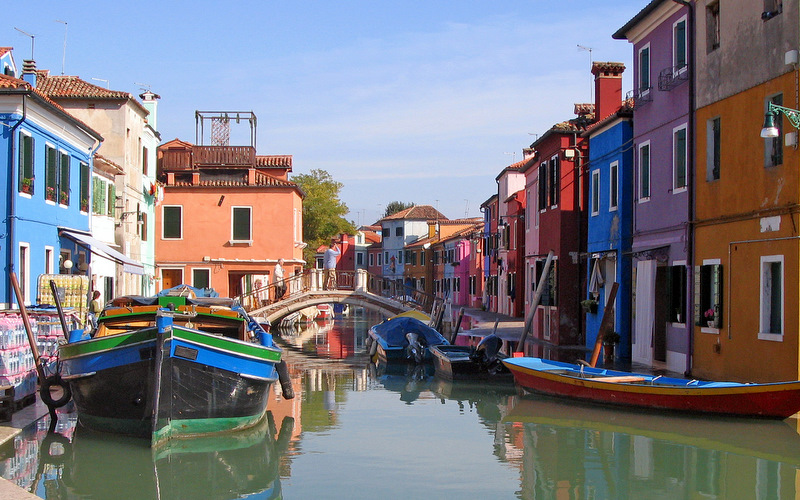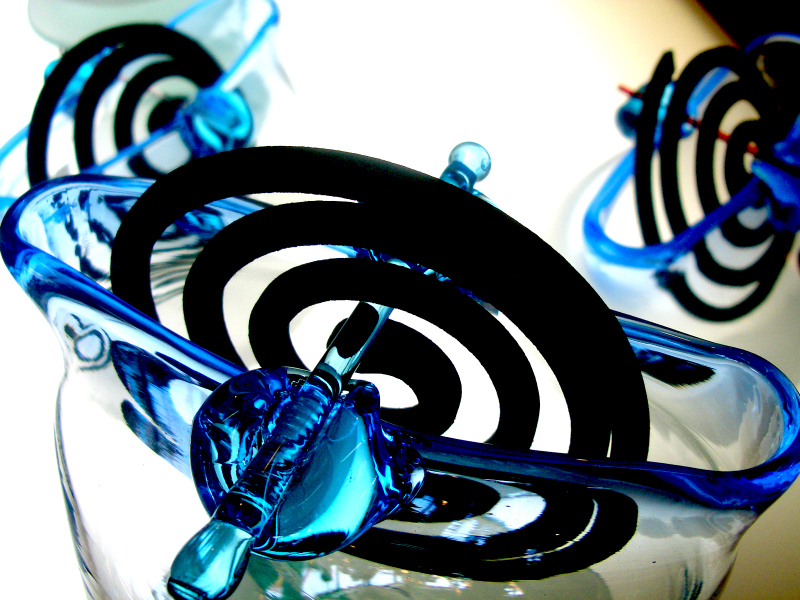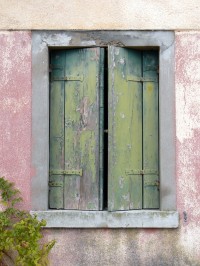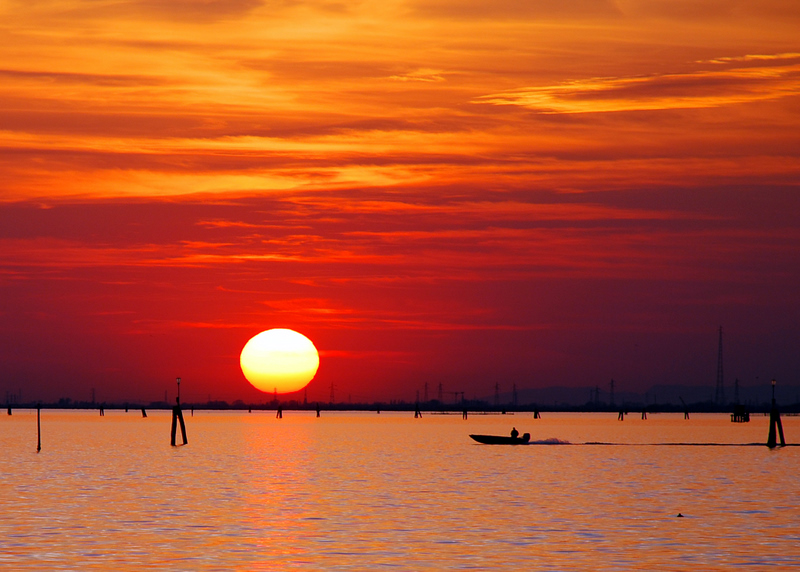Venice, the island jewel of the Renaissance, offers visitors more than high culture, a combative history and exquisite art. A brief trip on a vaporetto (passenger boat) or a ferry from Italy’s mainland can lead to one of the freestanding islands within the Venetian Lagoon. Despite the tourist trade, many of these islands have retained their local culture, architecture and traditional way of life. A one-day excursion is all you need to enjoy the islands of Venice.
Burano, the lace-making island
 A short island hop takes you from Venice to Burano. Famous for its centuries-old lace-making tradition, Burano is also a photographer’s paradise. Brightly colored buildings stand shoulder to shoulder along the canals. Peering through the house’s open shutters, you can catch snippets of life on this charming little island. Laundry, drying in private yards and public squares, adds a note of gaiety to the décor. Another typical sight of Burano is the San Martino Church with its impressive leaning bell tower that rivals the most slanting of Venice’s campanilos. Inside the church, you will admire a magnificent Crucifixion scene by Giambattista Tiepolo, Venice’s master painter of the 18th century.
A short island hop takes you from Venice to Burano. Famous for its centuries-old lace-making tradition, Burano is also a photographer’s paradise. Brightly colored buildings stand shoulder to shoulder along the canals. Peering through the house’s open shutters, you can catch snippets of life on this charming little island. Laundry, drying in private yards and public squares, adds a note of gaiety to the décor. Another typical sight of Burano is the San Martino Church with its impressive leaning bell tower that rivals the most slanting of Venice’s campanilos. Inside the church, you will admire a magnificent Crucifixion scene by Giambattista Tiepolo, Venice’s master painter of the 18th century.
How to get there:
From Venice, the easiest way to get to Burano is to take the LN (Laguna Nord) ferry from the Fondamente Nuove stop on Venice’s northern shore. Ferries run every half hour and the journey lasts 42 minutes. A boat also links Burano with the Lido, heading along the outer edge of the lagoon.
Murano, the glass island
 North of Venice, the island of Murano has been a glass maker’s paradise since 1291 after Venetian traders brought back from the east the secret of this craft. One of the best ways to appreciate the artisanal skill is to see glass making in action. Private tours will take you to workshops where a maestro vetraio (master glass-blower) can be seen withdrawing a dollop of molten glass from a red-hot oven with his blowpipe, then adeptly twisting and shaping the glowing gob into a graceful miniature doll. Like magicians, the maestros repeat the same procedure over and over with remarkable agility, each time creating an amazing art piece. If you are hungry for more, head toward the famed Rio dei Vetrai (the glass-blowers’ canal). It houses many of the glass island’s 100 workshops where teams of glass makers create artistic glassware and jewelry. The items are then displayed in boutiques in Murano and Venice. Enjoy this feast for the eyes and remember that Venetian glass remains a coveted gift that is always in fashion.
North of Venice, the island of Murano has been a glass maker’s paradise since 1291 after Venetian traders brought back from the east the secret of this craft. One of the best ways to appreciate the artisanal skill is to see glass making in action. Private tours will take you to workshops where a maestro vetraio (master glass-blower) can be seen withdrawing a dollop of molten glass from a red-hot oven with his blowpipe, then adeptly twisting and shaping the glowing gob into a graceful miniature doll. Like magicians, the maestros repeat the same procedure over and over with remarkable agility, each time creating an amazing art piece. If you are hungry for more, head toward the famed Rio dei Vetrai (the glass-blowers’ canal). It houses many of the glass island’s 100 workshops where teams of glass makers create artistic glassware and jewelry. The items are then displayed in boutiques in Murano and Venice. Enjoy this feast for the eyes and remember that Venetian glass remains a coveted gift that is always in fashion.
How to get there:
From Venice, you can take the boats 41 and 42. For shopping, you may want to get off at the boat’s first stop, Murano Colonna. There is also a direct boat, the DM, leaving from Tronchetto, Piazzale Roma and the railway station (Ferrovia). Murano’s Faro station is the first stop on the LN (Laguna Nord) ferry from the Fondamenta Nove on Venice’s northern shore.
Torcello, the evocative
 Just north of the glass island of Murano lies Torcello, the oldest continuously inhabited region of Venice. At one point, the population here reached a peak of 20,000. The island served as a refuge to Veneti fleeing the mainland during one of Venice’s ubiquitous wars. Today, however, less than 100 people live on this island. Nevertheless, every year, thousands of tourists flock here. One was Ernest Hemingway who wrote part of Across the River and into the Trees during his sojourn here. Visitors come to Torcello to soak up the atmosphere of Venice as it once was. A quiet canal leads the visitor to the heart of the island. Here, the gigantic Cathedral of Santa Maria Asunta, built in 639 AD, stands as testimony to a thriving past. And visitors to the cathedral will discover superb Byzantine mosaics that date to the 11th and 12th centuries. You too, as the rest of the crowd, may be pulled toward a much less grandiose-looking item: a simple stone seat, branded “the throne of Attila the Hun.” It actually has nothing to do with the King of the Huns – – but was most likely the bishop’s chair. The Church of Santa Fosca is also worth a visit. Built in the 11th century, the site boasts a large bell tower. The adventurous won’t let a fear of heights get in their way. After climbing the steep stairs, there is a spectacular view of the Lagoon and Venice in the distance that should not be missed.
Just north of the glass island of Murano lies Torcello, the oldest continuously inhabited region of Venice. At one point, the population here reached a peak of 20,000. The island served as a refuge to Veneti fleeing the mainland during one of Venice’s ubiquitous wars. Today, however, less than 100 people live on this island. Nevertheless, every year, thousands of tourists flock here. One was Ernest Hemingway who wrote part of Across the River and into the Trees during his sojourn here. Visitors come to Torcello to soak up the atmosphere of Venice as it once was. A quiet canal leads the visitor to the heart of the island. Here, the gigantic Cathedral of Santa Maria Asunta, built in 639 AD, stands as testimony to a thriving past. And visitors to the cathedral will discover superb Byzantine mosaics that date to the 11th and 12th centuries. You too, as the rest of the crowd, may be pulled toward a much less grandiose-looking item: a simple stone seat, branded “the throne of Attila the Hun.” It actually has nothing to do with the King of the Huns – – but was most likely the bishop’s chair. The Church of Santa Fosca is also worth a visit. Built in the 11th century, the site boasts a large bell tower. The adventurous won’t let a fear of heights get in their way. After climbing the steep stairs, there is a spectacular view of the Lagoon and Venice in the distance that should not be missed.
How to get there:
From Venice, take a vaporetto or ferry to Burano where another ferry will take you to Torcello.
Lido, the classy
 This small, sandy island stretches some 12 kilometers to the southeast of Venice. Facing Venice and the Lagoon on one side and the Adriatic Sea on the other, it is considered one of the most charming beach hideaways on the Adriatic Sea. Some claim that it was the first classy seaside resort in Europe. By the 1930’s, it could already count several luxury hotels. Today, the upscale, yet relaxed, atmosphere attracts people who want to escape the mainland’s chaos. Lido’s small piazzas, narrow and shaded streets are perfect for a nice afternoon stroll. Beautiful mansions, pastel-colored houses and elegant stores line Piazzale S.M. Elisabetta, the main avenue that leads to the beach. Come September, Lido’s hotels are filled with the rich and famous. Indeed, the island is home to one of the world’s oldest film festivals: the Venice Film Festival.
This small, sandy island stretches some 12 kilometers to the southeast of Venice. Facing Venice and the Lagoon on one side and the Adriatic Sea on the other, it is considered one of the most charming beach hideaways on the Adriatic Sea. Some claim that it was the first classy seaside resort in Europe. By the 1930’s, it could already count several luxury hotels. Today, the upscale, yet relaxed, atmosphere attracts people who want to escape the mainland’s chaos. Lido’s small piazzas, narrow and shaded streets are perfect for a nice afternoon stroll. Beautiful mansions, pastel-colored houses and elegant stores line Piazzale S.M. Elisabetta, the main avenue that leads to the beach. Come September, Lido’s hotels are filled with the rich and famous. Indeed, the island is home to one of the world’s oldest film festivals: the Venice Film Festival.
How to get there:
By vaporetto from Burano or from Venice.


Comments